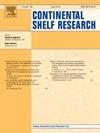Microstructures along the Indian west-coast continental shelf: layering and vertical mixing
IF 2.2
3区 地球科学
Q2 OCEANOGRAPHY
引用次数: 0
Abstract
During the month of October, the West Indian Coastal Current (WICC) is in a stage of transition from equatorward to poleward flow. The sea surface salinity near the Indian Coast is lower in the south compared to the north. Whereas the sea surface temperature is higher in the north than in the south. A salinity maximum (SM, Salinity 35.7 psu) exists in the sub-surface between depth ranges of 50–80 m. In situ vertical microstructure profiles collected along the continental shelf off the West Coast of India (WCI) for the first time, are used in this study to characterize vertical mixing under these complex thermodynamic regimes. Estimated sectional mean (median) values of the dissipation rates of turbulent kinetic energy () and thermal variance () are in the range () W kg−1 and () s−1 respectively. Sectional mean (median) values of the diapycnal diffusivity () and eddy thermal diffusivity () are in the range () m s−1 and () m s−1, respectively. The barrier layer (BL) was observed at most of the measurement locations. The layering structures in the salinity profiles observed within BL indicate the phase of transition of halocline reformation. Experiments using a one-dimensional model suggest that this layering is caused by the mixing of surface freshwater (surface freshening caused by heavy rains) with mixed-layer water. Double diffusion with weak staircase structures in temperature and salinity is observed predominantly in the interior layer of the ocean in this region. The presence of SM at most stations, with its thickness decreasing from north to south, created conditions favorable for double-diffusive mixing. Signatures of salt fingering (SF) and diffusive convection (DC) were observed in 40% and 8% of the water column, respectively. Turbulent mixing in the column below the mixed layer (ML) is weak ( m s−1) to moderate ( m s−1), with some highly turbulent intermittent regions ( m s−1) conducive to DC. The data presented here show the prevalence of two mixing regimes in the vertical: (1) vertical mixing of freshwater (due to rain) with the ambient mixed layer water, and (2) small-scale double-diffusive mixing due to contrasting temperature–salinity gradients predominantly in the ocean’s interior layer (below the isothermal layer).
印度西海岸大陆架的微观结构:分层和垂直混合
在10月份,西印度海岸流(WICC)正处于由赤道向极地流动转变的阶段。印度海岸附近的海面盐度在南部比北部低。然而,北方的海面温度比南方高。地下50 ~ 80 m深度存在盐度最大值(SM,盐度≥35.7 psu)。本研究首次在印度西海岸大陆架(WCI)收集了垂直微观结构剖面,用于表征这些复杂热力学制度下的垂直混合。估计湍流动能耗散率的截面平均值(中位数)和热方差(χ)分别在10−9−10−8(10−9−10−8)W kg−1和10−8−10−7(10−9−10−8)°C 2s−1范围内。横截面平均值(中位数)分别为10−6−10−5(10−6−10−5)m2 s−1和10−4−10−2(10−6−10−4)m2 s−1。在大多数测量位置均观察到阻挡层(BL)。BL内盐度剖面的层状结构反映了盐斜改造的过渡阶段。使用一维模型的实验表明,这种分层是由表层淡水(暴雨引起的表层清新)与混合层水混合造成的。该地区主要在海洋内层观测到具有弱温度和盐度阶梯结构的双重扩散。SM的存在为双扩散混合创造了有利条件,其厚度由北向南递减。在40%和8%的水柱中分别观察到盐指化(SF)和扩散对流(DC)的特征。混合层(ML)下柱的湍流混合是弱的(KT≤10−6 m2 s−1)到中等的(KT ~ 10−4 m2 s−1),有一些高湍流间歇区(KT ~ 10−2 m2 s−1)有利于直流。这里提供的数据显示了垂直方向上两种混合模式的普遍性:(1)淡水(由于降雨)与环境混合层水的垂直混合,以及(2)主要在海洋内层(等温层以下)由于温度-盐度梯度的对比而产生的小规模双扩散混合。
本文章由计算机程序翻译,如有差异,请以英文原文为准。
求助全文
约1分钟内获得全文
求助全文
来源期刊

Continental Shelf Research
地学-海洋学
CiteScore
4.30
自引率
4.30%
发文量
136
审稿时长
6.1 months
期刊介绍:
Continental Shelf Research publishes articles dealing with the biological, chemical, geological and physical oceanography of the shallow marine environment, from coastal and estuarine waters out to the shelf break. The continental shelf is a critical environment within the land-ocean continuum, and many processes, functions and problems in the continental shelf are driven by terrestrial inputs transported through the rivers and estuaries to the coastal and continental shelf areas. Manuscripts that deal with these topics must make a clear link to the continental shelf. Examples of research areas include:
Physical sedimentology and geomorphology
Geochemistry of the coastal ocean (inorganic and organic)
Marine environment and anthropogenic effects
Interaction of physical dynamics with natural and manmade shoreline features
Benthic, phytoplankton and zooplankton ecology
Coastal water and sediment quality, and ecosystem health
Benthic-pelagic coupling (physical and biogeochemical)
Interactions between physical dynamics (waves, currents, mixing, etc.) and biogeochemical cycles
Estuarine, coastal and shelf sea modelling and process studies.
 求助内容:
求助内容: 应助结果提醒方式:
应助结果提醒方式:


